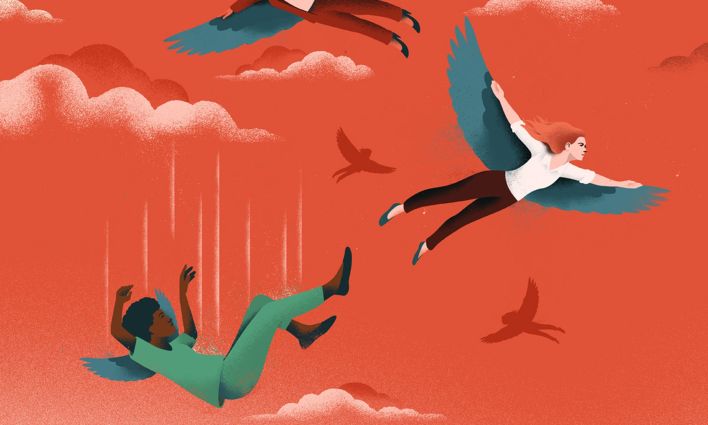Women and gender-diverse workers’ participation in the Canadian labour market might be in better shape than it was at the beginning of last year, but far too many are still being left behind.
Women’s employment rate is still trending below its pre-pandemic level. The number of long-term unemployed—both men and women—who have been out of work for more than a year is stubbornly high. And another 250,000 people have left the job market altogether, the vast majority of whom are women over the age of 55.
The true measure of the economic recovery must be assessed by the progress of the most marginalized. On that score, there is a long road ahead.
Where are we on our path to recovery?
In early fall, there was some talk of mass resignations and workers seeking out better work-life balance, but there’s no decisive evidence of this happening in Canada right now. Instead, we are seeing a shift in employment between industrial sectors.
Recent job growth has been largely concentrated in high-paying industries, such as professional and technical services, and in mid-paying sectors such as public administration and education, both important employment sectors for women.
Despite very high vacancy rates in health care and social assistance, there’s been only modest growth—28,000 women’s jobs over the last two years. Meanwhile, employment remains depressed in food and accommodation and in personal services (e.g., hair salons and catering companies).
The upshot—and something that demands further study—is that there has been a shift of some women up the wage grid, from lower-paying jobs to higher-paying jobs, albeit not as highly paid as men’s jobs. A January 22, 2022 Toronto Star article asked whether a “great realignment” wasn’t underway, with this shift in employment to higher paying sectors and occupations.
It’s important to say that women remain almost twice as likely as men to be employed in low-wage work. Higher vacancy rates in industries like hospitality and health care have triggered only modest wage growth to date, lagging the current rate of inflation. Low-wage employers have yet to change up their business models in any widespread way and offer higher wages to attract staff back
In short, there is a recovery for some, but not for all sectors, and certainly not for all groups.
Behind the headline statistics
In our haste to put the pandemic behind us, we can’t lose sight of the many marginalized people—women and gender-diverse people among them—who are still struggling economically.
First, most obviously, is that hundreds of thousands of women, including Indigenous and racialized women, women with disabilities and gender-diverse people, are employed in lower-paying occupations and continue to struggle with recurring waves of COVID-19 and the failure of governments to institute necessary protections, such as paid sick leave and caregiving supports.
Workers in these vulnerable sectors have experienced some of the greatest turmoil and economic volatility. Emergency benefits now offer limited respite, but the precarity of their current situation remains acute. Levels of employment among women in these sectors were still roughly 10% below pre-pandemic levels as of December 2021.
As noted, we have also seen a significant drop in employment among women aged 55 and older since February 2020. A combination of factors is driving the exodus, such as higher levels of illness, greater caregiving responsibilities for younger children or other family members with health challenges, and the accumulated stress of working in essential services during the pandemic. This group seems to have fallen off the recovery radar.
So, too, have lone-parent families who, along with other Canadian families with children under 12, are dealing with the current chaos of child care and schooling during the Omicron wave. Levels of employment among lone parents with children under the age of 6 have shown little improvement since the historic losses experienced during the spring of 2020. As of December 2021, lone-parent employment was 36% below February 2020 levels and 12% below for single moms with children ages 6-to-12.
All of which begs the question: how are these women putting food on the table? What is their long-term economic future? How will we close this widening gender gap?
Transformation or confirmation? Where to next?
Disasters can be “transformative or confirmatory,” Stephen Lukes writes. They can generate new ways of thinking or they can reinforce prevailing structures of power.
Conditions appear to be ripe for advancing progressive alternatives. There is a greater awareness of the gendered impact of the pandemic and new constituencies advocating for change. Growing labour shortages, notably in health care, and the current transformation of low-wage industries, such as hospitality, focus our attention on poor working conditions and dismal levels of pay, potentially opening up new avenues for women and gender-diverse people to improve their economic standing.
Certainly, the new federal child care program is a huge win, building on decades of research and committed advocacy on the part of the child care community and the women’s movement. This could represent a real turning point. But, it isn’t clear whether the agreements that have been struck with provincial and territorial governments will deliver on the promise of a universal public system.
We have also seen moves to expand the use temporary foreign workers and other “volunteers” to address critical shortages in Canada’s health care sector, as well as the introduction of new gig platforms such as Staffy and BookJane into long term care—developments that will further exploit care workers and erode the foundations of quality care.
Other gaps in community services have gone unaddressed. This is mainly the result of, among other things, jurisdictional conflict, a history of government neglect, privatization of services, and a deep-seated gender bias (more evident in some jurisdictions than others) that assumed that women would just get on with it.
I fear that we may be seeing a deepening—a “confirming”—of established intersectional disparities in the labour market between low-paid, precarious workers labouring in exposed occupations such as care jobs and “triple-protected” workers whose economic fortunes have only been enhanced throughout the pandemic with the increase in housing prices and the value of investments.
What is certain, however, is that without focusing and sustaining recovery efforts on the needs of those who are experiencing the greatest barriers, progress towards greater gender equality will be rolled back, prolonging the recovery for the most marginalized people and communities that have borne the worst of the pandemic.
As we head into budget season, the question we should be asking is: recovery for whom? It would be a tragedy if the lessons learned from the pandemic were ignored and governments reverted back to the old ways of doing business, leaving millions behind again.







